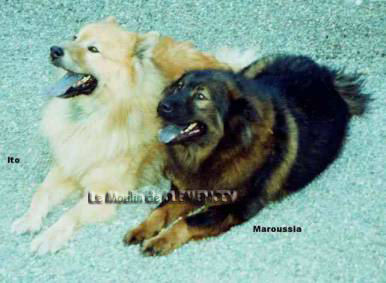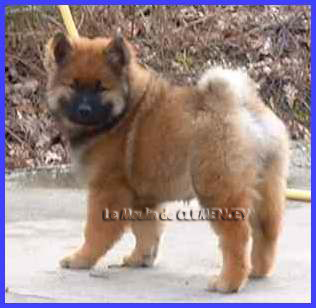
The
Eurasier originated centuries ago among tribes living in central Siberia. These
remote Russian people
domesticated primitive dogs, descendants of the Wolf-Spitz and Chow-Chow, which
they named the Laïka.
The
present-day, Eurasier is similar to the Laïka. During the 1950s, when the
export of Soviet dogs was prohibited, German scientists, led by Professor Konrad
Lorenz, decided to revive the breed by crossing a female Wolf-Spitz with a male
Chow-Chow.
The
actual developer of the breed, Julius Wipfel, named the offspring Eurasier.
This new
species, now well established, was recognized by the Fédération cynologique
internationale in 1973.

The
Eurasier, a newcomer among dog breeds, was developed by scientists and
researchers working in Germany during the early 1950s. Its name
evokes its European and Asiatic ancestry - the Wolf-Spitz and the Chow-Chow- and
it combines many of their qualities.
Like
the Wolf-Spitz, a close relative of the Keeshond, this dog is elegantly but
solidly built, and has a sumptuously rich coat in red to sand, pale yellow,
black, or grey. The eyes, set in a fox-like head, have a frank, intelligent
expression.
From the Chow-Chow, the Eurasier inherits a tender and affectionate nature. It is a clean and quiet dog. It makes an ideal companion dog and is well suited to family life. It enjoys children and adopts a paternal attitude with infants, never displaying the slightest jealousy towards them. Because the Eurasier needs company, it may refuse to be excluded from the household - to be put in a kennel or tied up outdoors.

The
Eurasier seems to have a sense of humour, especially during its mischievous
first few months. When the dog matures, it becomes more reserved and equable in
temperament. Nevertheless, adult dogs can still be extremely playful.
The
Eurasier is very loyal to its mate, and it is friendly with other dogs. Its is
something of a charmer with cats. Even the most timid felines can rarely resist
its attraction.
Easy
to train, the Eurasier is an attentive, vigilant guard dog when protecting its
human family. It barks only when necessary, but hardly ever attacks. When
provoked, it emits a deep growl similar to that of its earliest forbear, the
wolf.
Practical informations :
This vigorous dog is rarely ill and adapts easily to different
environments. The Eurasier requires minimal exercise. With appropriate
affection and care, the Eurasier lives happily within the human family circle.
Unlike the Chow-Chow, it is unaffected by seasonal changes, and it rarely
suffers from eczema. Bathe the dog several times a year. Its coat, particularly
the long hair on the tail, rump, and forelegs, requires regular brushing.
Characteristics
General appearance
:longer than it is wide, the eurasier is of average height. The head of this dog
is shaped like that of the wolf.
Height : 52 to 60 cm (20 to 23 in.) for the adult dog ; 48 to
56 cm (19 to 22 in.) for the bitch.
Weight : 25 to 30 kg (55 to 66 lb) for the adult dog ; 20 to
26 kg ( 44 to 57 lb) for the bitch.
Head : wedge-shaped, muzzle medium length, not foxy. Skull
flat with a pronounced stop widening slightly towards the skull. Nose medium
size. Jowls flat, not pendulous, with black pigmentation, which is also found on
the mucous membranes, eyelids, and nose. Strong scissor bite.
Eyes : Dark, not deep-set, almond-shaped. Dignified appearance.
Ears : Average size, erect, not far apart.
Neck : Head held high and attached to the shoulders by a
muscular, well-set-on neck.
Body : Muscular shoulders. Well-curved, deep chest, Curved
ribs. Solid, straight back extended by a long, wide croup ; pelvis is angled to
the hindquarters. Chest deep with gradual tuck-up.

Tail : Reaching hocks while at rest, it curls up on the
back and sideways when the dog is moving.
Forequarters
: Forelegs perfectly straight and stiff down to the feet.
Hindquarters
: muscular thighs, hocks well let down, perfectly straight.
Feet : Strong, cat-footed. Toes arched and close. Thick,
heavy-duty pads.
Coat : The entire body of the Eurasier is covered with a
short, dense undercoat and a medium-length outer coat. Long hair on the tail,
rump, and forelegs. The mouth, jaw, and under-side have short hair. The coat
around the neck is slightly longer than on a body, although it should not
resemble a mane.
Colour : Red to sandy shades or pale yellow, grey-black and black with fainter markings around the eyes and on the rump and tail.
Faults
: Head too heavy or pointed. Hind legs too rigid,
making the dog seem to be "walking on stilts". Undercoat too thick, making the coat too dense. Jaw
and upper part of the face forming a snippy muzzle. Eyes too light or too dark. Ears too far apart or
too small. Brindle coat. A dog which is aggressive, fearful or overly
nervous.
Back to top
![]()
![]()
|
|
Copyright © Jean-Claude Danjean - All rights reserved |